Philippine Consulate General in Frankfurt Brings Into Focus Country’s Intangible Cultural Heritage in 2020 National Heritage Month
PH Consulate General in Frankfurt Brings Into Focus Country’s Intangible Cultural Heritage in 2020 National Heritage Month Celebration: https://bit.ly/2X6hvna
As part of its virtual cultural diplomacy initiatives and this year’s National Heritage Month celebration, online videos and infographics were produced by the Philippine Consulate General in Frankfurt to bring into focus several of the country’s intangible cultural heritage (ICH) elements inscribed in the United Nations Educational, Scientific and Cultural Organization’s (UNESCO) Representative List of the Intangible Cultural Heritage of Humanity and other elements.
The said elements are being proposed for nomination by the Philippines for inclusion in the intangible cultural heritage lists.
With this year’s theme, “Mga Kuwentong Pamana” (Stories of Heritage), the online advocacy aims to align Filipinos’ goal of preserving and promoting their local culture and tradition. The Consulate also hopes that the increased online discussion of the country’s intangible cultural heritage could deepen their sense of pride of their cultural heritage.
The initial video, which was published on 06 May 2020 on the Consulate’s website and Facebook page, introduced four elements of the Philippines’ intangible cultural heritage inscribed in UNESCO’s list, namely: the “Buklog, Thanksgiving Ritual System of the Subanen,” which was inscribed in the UNESCO list last year; the “Punnuk, Tugging Rituals and Games of the Ifugao” inscribed in 2015; the “Hudhud Chants of the Ifugao and the “Darangen Epic of the Maranao People of Lake Lanao” which were both inscribed in 2008. The video garnered over 1,200 views and 60 likes on Facebook and stirred much online interests among viewer.
Meanwhile, the infographics of the 15 elements being proposed for inclusion in the UNESCO list are uploaded each day until the end of the month. These include the following: (1) “Kapayvanuvanuwa” Fishing Ritual of the Ivatan of Batanes; (2) “Batek/Batok” Tattoo-making Tradition of the Butbut People of Kalinga; (3) “Ati-atihan festival” of the people of Aklan; (4) Metal and wood craftsmanship of the Maranao of Lanao; (5) “Tepo” mat weaving of the Sama people of Tawi-tawi; (6) Traditional Boatbuilding and Maritime Culture of the peoples of Batanes and Tawi-tawi; (7) Tradition of “Atang” of the Ilocano people; (8) Cosmology of the Mangyans of Mindoro; (9) “Moriones festival” of the people of Marinduque; (10) “Hinilawod Epics” of the people of Panay; (11) “Ulaging Epic” of the Talaandig Manobo of Bukidnon; (12) “Kudaman Epic” of the Pala’wan people of Palawan; (13) “Apung Iru fluvial festival” of the Kapampangan people of Apalit; (14) Kalibo Piña weaving of the Aklanon people of Aklan; and (15) “Digdiga Ni Tupayya courtship dance” of the Kalinga people.
Intangible cultural heritage includes traditions or living expressions inherited from ancestors and passed on to descendants, such as oral traditions, performing arts, social practices, rituals, festive events, knowledge and practices concerning nature and the universe or the knowledge and skills to produce traditional crafts. While most of the elements are fragile, intangible cultural heritage is an important factor in maintaining the Philippine cultural diversity in this digital age.
The month of May is declared National Heritage Month by virtue of Presidential Proclamation No. 439 s. 2003.
#MgaKuwentongPamana
#NHM2020
#CulturalDiplomacy
#HeritageDiplomacy
#DFAinACTION
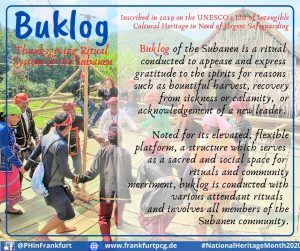
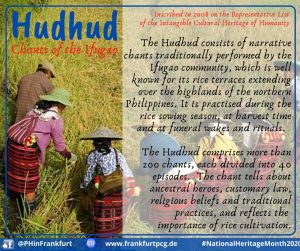
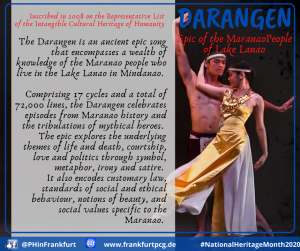
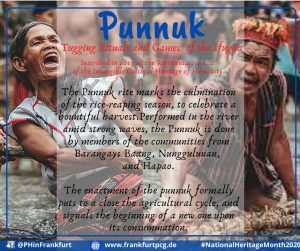
National Flag Days

NCCA’s Pamana Trivia
Learn more about the Heritage Law!
Celebrate heritage month Visit: https://ncca.gov.ph/
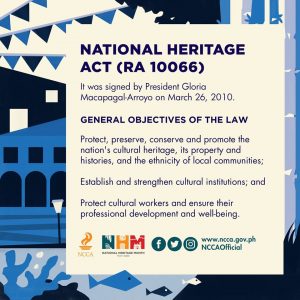
National Heritage Month 2020 – Hinilawod Epics of the People of Panay
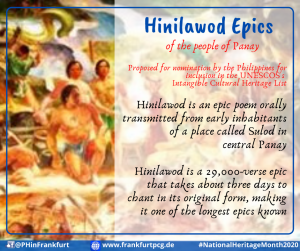
National Heritage Month 2020 – Digdiga ni Tupayya Courtship Dance of the Kalinga People
The “tupayya” (dance) is a great story of a community engagement involving members, during courtship between a man and a woman.
It is unique tradition that deserves worldwide recognition.
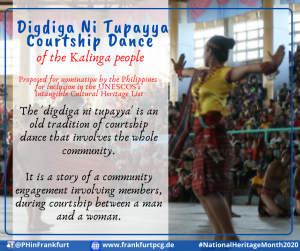
National Heritage Month 2020 – Ulaging Epic of the Talaandig Manobo of Bukidnon
The Ulaging is an epic cycle among the Talaandig Manobo of Bukidnon, Mindanao. Like most epics, it s aasociate with the sacred as the deities invoked.
The Manobo culture has its own worldview, and this epic reveals their interpretation of life. To go into the core of the Ulaging is to go the core of the meaning of life according to the Talaandig Manobo.
Dive into the PH’s intangible cultural heritage.
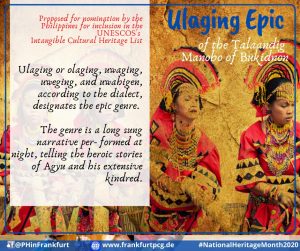
National Heritage Month 2020 – Hudhud
The Hudhud consists of narrative chants traditionally performed by the Ifugao community, which is well known for its rice terraces extending over the highlands of the northern island of the Philippine archipelago. It is practised during the rice sowing season, at harvest time and at funeral wakes and rituals. Thought to have originated before the seventh century, the Hudhud comprises more than 200 chants, each divided into 40 episodes. A complete recitation may last several days.
The conversion of the Ifugao to Catholicism has weakened their traditional culture. Furthermore, the Hudhud is linked to the manual harvesting of rice, which is now mechanized. Although the rice terraces are listed as a World Heritage Site, the number of growers has been in constant decline.The few remaining narrators, who are already very old, need to be supported in their efforts to transmit their knowledge and to raise awareness among young people.
WATCH: UNESCO’s full video here: https://ich.unesco.org/…/…/hudhud-chants-of-the-ifugao-00015
National Heritage Month 2020 – Metal and Wood Craftsmanship of the Maranao of Lanao
Lanao del Sur is a wealth of old-world charms. From ostentatious royal houses to the tiniest detail in their gongs, Maranao arts and crafts carry the stories of its vibrant culture. Everywhere you look around there’s always a reminder of how art thrives amidst its episodes of struggles.
Learn more about the stories of each carving.
Dive into the PH’s intangible cultural heritage!
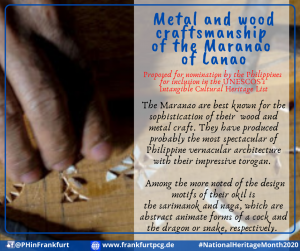
National Heritage Month 2020 – Cosmology of the Mangyans of Mindanao
The Hanunoo Mangyan’s universe is known as sinukuban (dominion) or kalibutan (all that surrounds). All existence, visible and invisible, is embraced in this concept. The universe has an ellipsoidal shape like a coconut, composed of plural strata (‘oklot) and between one stratum and another is the pawa’ (interval space).
This is just a part of the concept of cosmology of the Mangyans in Mindoro. Know more about their stories of the earth and the universe.
Dive into the Philippines’ intangible heritage culture!
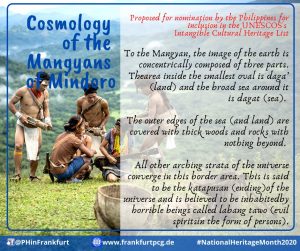
- « Previous Page
- 1
- …
- 17
- 18
- 19
- 20
- 21
- …
- 29
- Next Page »